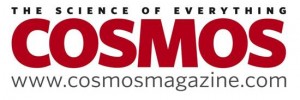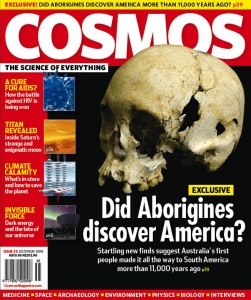The idea that Australian Aborigines may have been the first humans in the Americas may be “startling” but it isn’t “new”.
The attachment to this message is an article from Scientific American that was published in 2005 on the same subject.
Chris Forbes-Ewan
19 Hedley St
Scottsdale Tas 7260
From: asc-list-bounces@lists.asc.asn.au [mailto:asc-list-bounces@lists.asc.asn.au] On Behalf Of Wilson da Silva Sent: Friday, 1 October 2010 9:32 AM To: asc-list@lists.asc.asn.au Subject: [ASC-list] COSMOS EXCLUSIVE: Did Australian Aborigines reach America first?
http://www.vision6.com.au/download/files/08123/939809/Cosmos_wURL.jpg
http://www.vision6.com.au/ch/8123/2ddsb3q/1325278/1409a139m4.html http://www.vision6.com.au/ch/8123/2ddsb3q/1325278/1409a139m4.html Image http://www.vision6.com.au/ch/8123/2ddsb3q/1325278/1409a139m4.html FOR IMMEDIATE RELEASE – 1 OCTOBER 2010
EXCLUSIVE: Did Australian Aborigines reach America first?
Startling new archaeological finds are set to rewrite the record books, suggesting that the Americas were settled more than 11,000 years ago by the first Australians.
A detailed investigation in the October issue of COSMOS, Australia’s #1 science magazine, details the astonishing discovery of scores of ancient human remains in Brazil, Chile and Florida – some more than 11,000 years old – with cranial features distinctive of Australian Aborigines.
The oldest of the skeletal remains, dubbed Luzia, are of a young woman who died in her twenties and was ceremonially buried in a cave complex in Central Brazil. She was among a large collection of material first uncovered in 1975 by a Brazilian-French archaeological team, who disbanded in acrimony after the sudden death of its leader.
The remains were not examined until he late 1990s by a group led by Walter Neves of the University of Sao Paulo, who was surprised to discover that Luzia’s skull looked sharply different from the Mongoloid cranial morphology distinctive of people of East and North Asian origin and of Native Americans.
A reconstruction of her face by British forensic experts, based on her skull and its distinctive characteristics, shows Luzia had a cranial morphologyalmost identical to Australian Aborigines.
COSMOS Deputy Editor Jacqui Hayes, who travelled to Brazil to research the nine-page cover story, recalls seeing the evidence with her own eyes.
“When I was in the lab, I was amazed to walk around the reconstruction of Luzia’s skull, which clearly looked Aboriginal, and yet realise this was found a world away and was so very ancient,” she said. “Clearly, ancient humans did a lot more than we give the credit for.”
For more information, to read a copy of the story or images, contact Kylie or Becky on 0416 196 942 or 02 9310 8508.
A video of Luzia’s skull reconstruciton can be found at http://www.youtube.com/v/Xbkp2JP2_ck
Please credit COSMOS magazine as the source of your story
_______________________________________________ ASC-list mailing list list@asc.asn.au http://www.asc.asn.au/index.php?option=com_content&task=view&id=97&Itemid=115




